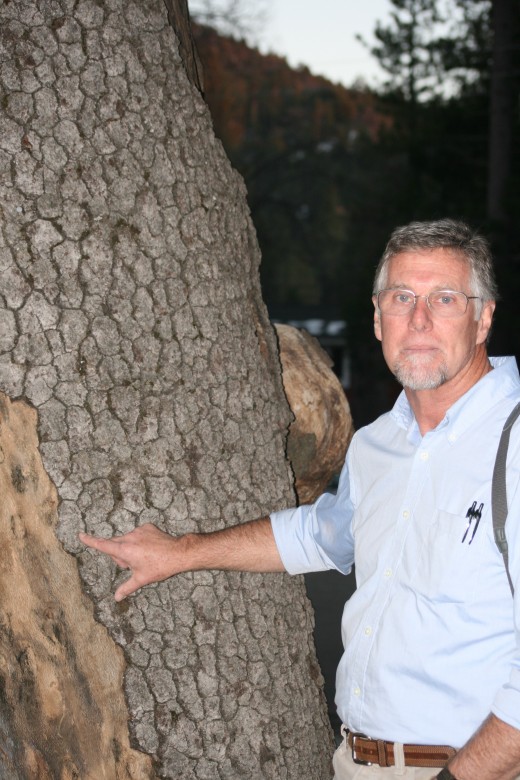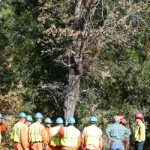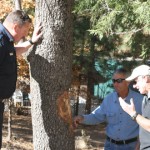There was an audible gasp when Mountain Battalion Chief Gregg Bratcher announced to a packed Town Hall meeting that there are two more confirmed Goldspotted oak borer infected trees in Idyllwild. GSOB has already inflicted high mortality rates on San Diego County oaks, at levels not seen before. The November confirmation of GSOB arrival in Idyllwild, 30 miles north of its last point of detection in San Diego County, was almost certainly the result of firewood transported from San Diego County. Key GSOB scientists, Third District Supervisor Jeff Stone, representatives from CAL FIRE, U.S. Forest Service and the Hill's Mountain Communities Fire Safe Council spoke at the Saturday, Jan. 19 meeting about the threat to Hill oak stands, potential costs to landowners of tree removal and affects on property values.
"We want to get the word out and help you help yourself protect your property," said Bracher. He said that the two new confirmed GSOB infections makes it more likely that the problem is more widespread than previously hoped.

In opening remarks, Supervisor Stone said that the Board of Supervisors is working on a firewood transportation ordinance. "We're working on an ordinance that will make it more punitive for imported oak," he said. "Code Enforcement can't be here 24 hours so we're asking you, the public, to tell roadside sellers it is unlawful. Get their license plate numbers and call my office. We must make sure this does not spread. There really is no cure other than trying to prevent its spread." He then noted, as did subsequent presenters, that the full scale of devastation may not be seen until the spring and that he is committing all the resource of his office to this fight. "We all need to be involved to prevent the spread."
Toni Bertholette, Idyllwild Garden Club president, said that the group plans to install signs at the base of the Hill, advising against importation of oak to the Hill.
Lead GSOB scientist, Dr. Tom Coleman of the U.S. Forest Service said that surveys in areas between Idyllwild and San Diego County revealed no GSOB. "It must have been brought in by firewood," he said. He said that before confirmation of GSOB in California, oak mortality was very low. With its arrival, GSOB oak infestation rates spiked to 90 percent, with 45 percent mortality to date, with mortality rates likely to increase with time. He also said altitude is no defense, since GSOB survives well in eastern Arizona mountains and in high altitude, 6,000 feet plus, San Diego County mountains.
He said landowners with oak should monitor their trees closely for: crown thinning, bark staining, D-shaped exit holes and extensive woodpecker foraging.
Coleman said that GSOB research only began in California in 2008 so the science of how to combat spread is in its infancy.
Each speaker advised not to transport firewood, even within Hill neighborhoods, now that GSOB infestation is local. Dr. Tom Scott, UC Riverside, said this is a community issue. "Treat it like a public health emergency, how to contain an outbreak," he advised. "We have never seen rates of oak mortality such as we have seen in San Diego County. Our [California oak] trees don't have much resistance. We have never found a tree that has successfully fought of GSOB. We desperately need to find all infected trees."
Fire Safe Council Executive Director Edwina Scott said her organization is launching a volunteer effort to identify infected trees. "We're starting a pilot program for volunteers," she said noting that the key scientists are not regularly available in Idyllwild to identify all infected trees. "Everyone should consider themselves volunteers," she said. "We'll need more people out there. We have one hope [to contain this outbreak] and that is each and every one of you."
For more information on GSOB and to report possible infestations, visit www.GSOB.org











I try to keep up on the GSOB problem and read everything that is in the Town Crier on the subject. Thanks for the information. It is helpful for all of as concerned property owners.
One thing you might consider — The article in the January 24th issue of the Town Crier (print version) gives contact points for persons who feel they have spotted GSOB signs in their oaks, and want to inform officials. This very valuable information does not seem to be in the web version of the article (which is perhaps the only verson some readers will ever see).
I feel it would have been good to print the full article with that very important information included.
This comment is for TC personnel and not intended to be printed (although you may if you wish).